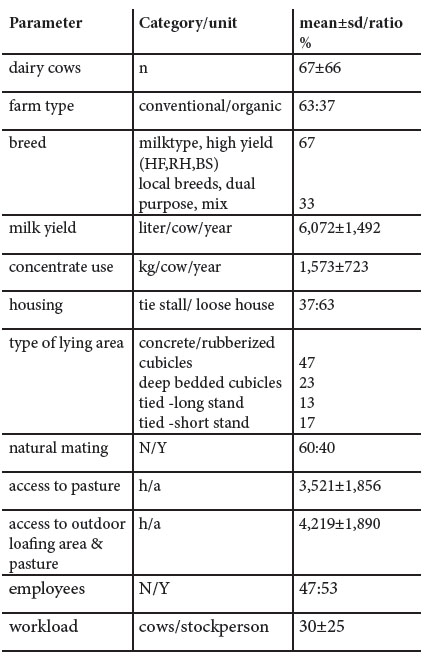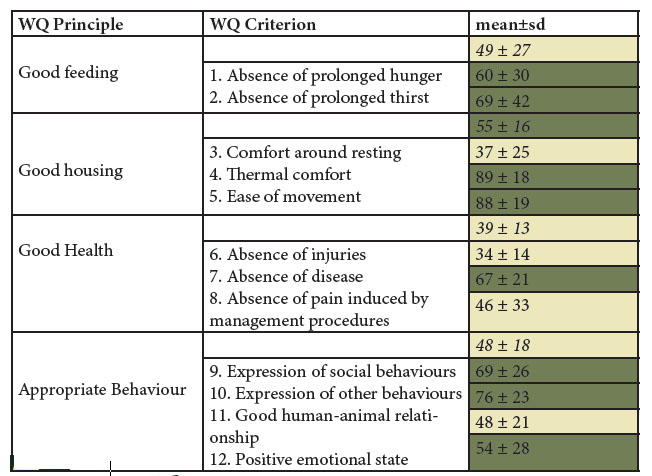Animal welfare state on the farms studied in three different countries was mostly found to have an acceptable to enhanced level according to Welfare Quality®. Between-farm variation showed that welfare improvement may be necessary in organic and low-input dairy systems but that good to even excellent results may equally be achieved.
By Marlene K. Kirchner & Christoph Winckler, University of Natural Resources and Life Sciences (BOKU), Vienna, WP2
The management of low-input and organic dairy systems differs from that of intensive conventional production units. Especially the fact that pasturing is frequently used in these systems is perceived as more animal friendly (Reijs et al., 2013), but only limited information is available on the actual welfare state of dairy cows in low-input systems. Therefore the aim of this task was to evaluate the welfare state of dairy cows in organic/low-input dairy systems in three European countries and to identify associations with system-specific factors and to develop risk-based improvement strategies.
Ten farms in each of the following regions: Ulster (Northern Ireland, UK), Asturias, Cantabria & Basque county (Spain) and Walachia and Transylvania (Romania) were identified and visited during winter and spring 2013. The method used to evaluate the farms was the Welfare Quality® (WQ) protocol, which follows a multi-dimensional approach thus covering different dimensions of animal welfare (Welfare Quality® 2009). It has a strong focus on animal-based parameters that are complemented by a few resource- and management-based measures. In the aggregation and evaluation procedure, data from a total of 28 measures are aggregated to 12 criteria and four principle scores, which may range from 0 to 100 with a score of 50 representing a neutral state of animal welfare. In addition to the WQ scores, basic data describing the farming system were collected (table 1).

The farms
One third of the farms were organic and two thirds of the farms were conventional low-input farms. The proportion of organic farms varied between countries but was chosen according to the relative presence in the specific region. The average herd size was 67 lactating cows (range 15-320). Cows were mainly of dairy breeds such as Holstein, Red & British Friesian, Brown Swiss or crosses. Some farms kept dual-purpose breeds such as Simmental (Fleckvieh) or local breeds or crosses such as Asturiana, Tudanca or Pinzgauer. Cows were mainly housed in free stalls with concrete or rubberized cubicles. Three farms used an automated milking system and 12 farms kept a breeding bull. Half of the farms employed 1.3 stockpersons on average. The average workload was 30 cows per stockperson (range 7-100).
Major areas of concern and success in terms of animal welfare
At principle level, the lowest average scores were achieved for ‘Good Health’ (Table 2). This was mainly due to large percentages of cows having lesions and/or swellings (‘Absence of injuries’) and the lack of anaesthesia and post-surgical analgesia during dehorning/disbudding procedures (‘Absence of pain induced by management procedures’). Further problem areas at criterion level were ‘comfort around resting’ (mainly due to soiling of the animals) and ‘good human-animal relationship’ (increased avoidance distances towards human). The strengths of the systems were found in the criteria ‘Ease of movement’, ‘Absence of disease’, ‘Expression of social and other behaviours’ and ‘Positive emotional state’. The overall classification of the farms was ‘acceptable’ in 50% and ‘enhanced’ in 43% of the cases. One farm was rated ‘excellent’ and one farm was ‘not classified’ due to the poor welfare state. The high between-farm variation in almost all measures shows that welfare improvement may be necessary in organic and low-input dairy systems but that good to even excellent results may equally be achieved.

Outlook
Using statistical models, the relationship between indicators of welfare and factors related to management and housing will be investigated. Based on the associations identified, possible improvement strategies will be developed that may assist farmers and advisors in setting up herd health plans.
Many thanks to all partners providing excellent support in the three countries.
Literature
Welfare Quality® 2009. Welfare Quality® assessment protocol for cattle. Welfare Quality Consortium, Lelystad, Netherlands
